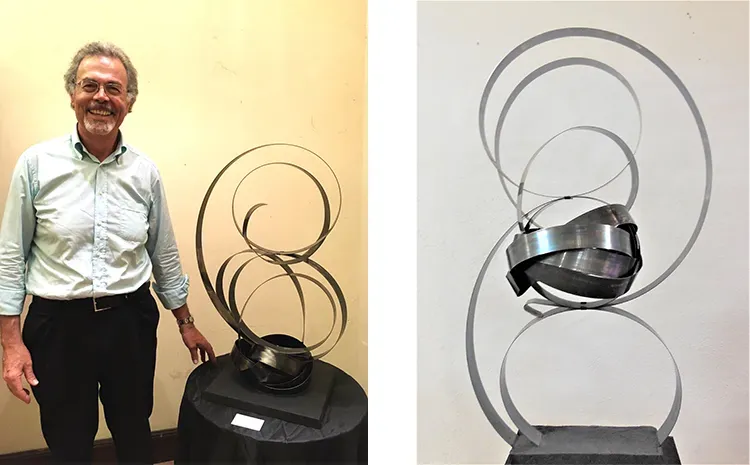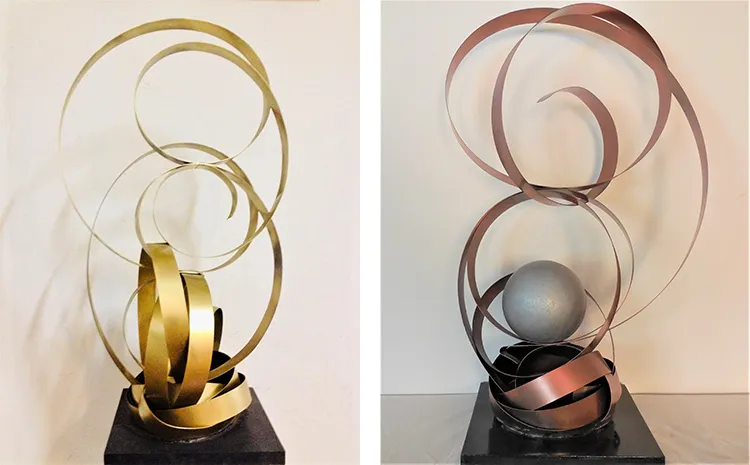“I see my role as an artist akin to that of a volcano—witnessing and participating in the cyclic dance of creation and destruction, of Eros and Thanatos.”
Crafting Spirituality in the Material World
From his beginnings in the bustling streets of Rome to the serene silence of his studio, Paolo Di Nozzi‘s artistic journey has been deeply intertwined with his dual expertise in industrial chemistry and sculpture. Di Nozzi first explored the deeper essence of materials during his academic tenure at La Sapienza University, where he completed a master’s degree in Industrial Chemistry. This unique blend of scientific insight and artistic sensibility has defined his approach to the Plastic Arts. For Di Nozzi, every material holds a spiritual narrative, waiting to be unveiled through art. His professional career as a manager in multinational chemical corporations expanded his horizons, exposing him to a plethora of materials that would later become central to his sculptures.
The artist’s transition from a corporate professional to a sculptor was fueled by his lifelong passion for art and a profound curiosity about the intrinsic energies of mundane objects. In Di Nozzi’s view, conventional materials are not just physical entities but vessels of latent spiritual stories. This perspective led him to challenge the traditional dichotomies of Western philosophy, which often separate spirit from matter. Through his sculptures, Di Nozzi seeks to dissolve these boundaries, showcasing how worn objects, such as metal springs, harbor unexplored energies and narratives. His approach is a testament to his belief that every piece of material can be transformed into a vibrant, spiritual entity.

Paolo Di Nozzi: A Volcano of Creation and Transformation
Metal springs, with their inherent tension and past of mechanical fatigue, fascinate Paolo Di Nozzi. He perceives them as symbols of potential energy and resilience, qualities that he aims to highlight and repurpose through his sculptural works. To Di Nozzi, the act of sculpting is akin to the processes of a volcano—both destructive and creative, encapsulating the profound cycles of Eros and Thanatos. By reshaping these springs, he not only alters their form but also redefines their existential narrative, transforming discarded mechanical parts into eloquent expressions of rebirth and continuity.
Di Nozzi’s philosophical approach to sculpture transcends the need for viewers to have a background in philosophy to appreciate his work. He endeavors to make complex concepts accessible, crafting each sculpture as a dialogue between thought and material. This dialogue is intended to be intuitive, allowing viewers to connect with the artwork on a visceral level. Each piece serves as a visual and tactile representation of philosophical ideas, strung together to form a coherent and captivating narrative. The simplicity of the visual experience belies the depth of thought behind it, inviting an immediate and profound understanding without the prerequisite of philosophical education.

The Interplay of Art and Audience
The reception of Paolo Di Nozzi’s work in both elite art circles and among the general public has been overwhelmingly positive, creating a unique dialogue between the artist and his audience. Exhibitions at prestigious venues like MACRO Testaccio and MACRO Asilo in Rome have showcased his innovative use of recycled materials, drawing praise from experts who draw parallels with the Arte Povera movement. This movement, known for its use of mundane materials to challenge economic and cultural values, resonates strongly with Di Nozzi’s own artistic philosophy. Critics and art lovers alike appreciate the tangible transformation of materials in his sculptures, which makes his work not only relatable but also deeply intriguing.
General viewers, irrespective of their familiarity with art history, find an immediate connection with Di Nozzi’s sculptures. His ability to transform seemingly lifeless materials into dynamic artworks engages viewers, offering them a journey through transformed shapes and energies. This universal appeal is a testament to Di Nozzi’s skill in communicating complex themes through his art. Whether one approaches his work with a deep understanding of its philosophical underpinnings or with simple curiosity, Di Nozzi aims to provide a fulfilling aesthetic and intellectual experience that resonates on multiple levels.

Paolo Di Nozzi: Philosophical Echoes in Sculptural Forms
Paolo’s artistic ethos is profoundly influenced by the desire to leave a lasting legacy, combating the fear of oblivion through the permanence of his sculptures. This drive is deeply entwined with his environmental consciousness, as seen in his commitment to repurposing waste materials. Di Nozzi believes these materials possess intrinsic spirits, and through his artistic process, he seeks to unveil and honor these latent qualities. The artist’s journey into public recognition began in earnest in 2012, following his retirement from the chemical industry, marking a significant pivot to full-time artistic creation based on principles he had nurtured throughout his life.
The informal yet strikingly poignant style of his sculptures can be categorized as three-dimensional artworks that continue the narrative of arte povera by embedding environmental sustainability into their core. Di Nozzi’s workspace, a chaotic yet creatively fertile environment, reflects his artistic method—organized enough to keep his tools within reach, yet disorderly enough to inspire. His sculptures are not just art pieces but are philosophical statements, engaging with themes proposed by thinkers like Giordano Bruno, who viewed matter itself as dynamic and divine. Each of Di Nozzi’s sculptures, from the groundbreaking “Égalité” to his latest creations, encapsulates a moment of material and spiritual synthesis, inviting viewers to reconsider the potential of the everyday.





